The American Robin (Turdus migratorius) emerges as a charismatic avian ambassador, gracing North American landscapes with its distinctive appearance and enchanting song.
Recognized for its warm orange-red breast, the robin serves as a herald of spring, capturing the collective imagination with its timely arrival.
This iconic songbird’s adaptability is evident in its ability to thrive in diverse environments, from woodlands to urban settings. Its melodious warble, coupled with the rhythmic head-cocking foraging technique, makes the
American Robin is a delightful and recognizable presence. Beyond its aesthetic appeal, the robin plays a crucial ecological role, contributing to insect control and seed dispersal.
Exploring the multifaceted aspects of this species offers a glimpse into the interconnected tapestry of nature, where the American Robin takes center stage as a symbol of renewal and enduring beauty.
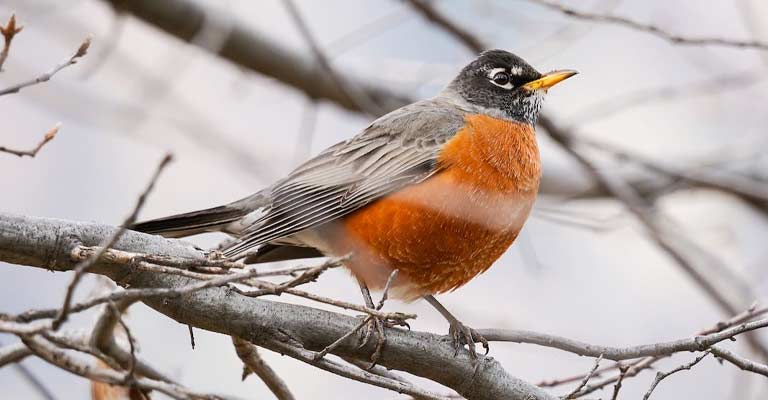
Identifying Characteristics
The American robin (Turdus migratorius) is a distinctive and easily recognizable songbird, known for its large size, vibrant plumage, and melodious song.
As the largest North American thrush, it boasts a robust physique with specific identifying characteristics that set it apart in the avian world.
Size and Shape
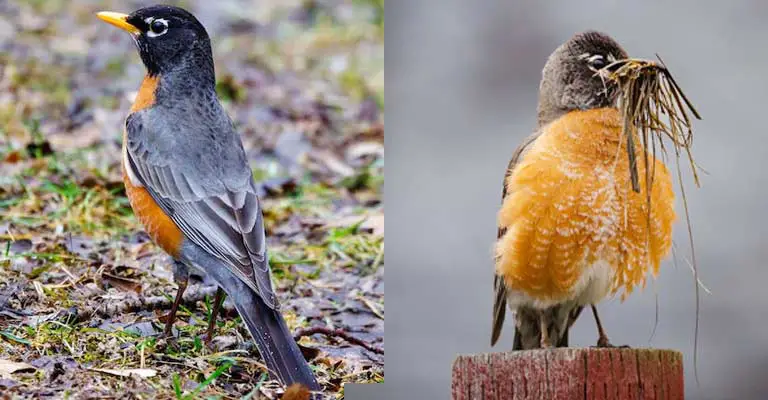
The American robin is a fairly large bird, almost half again as big as a bluebird.
It has a substantial, round body with a slightly elongated appearance, long legs, and a proportionately long tail. The body structure gives it an overall well-balanced and athletic look.
Plumage
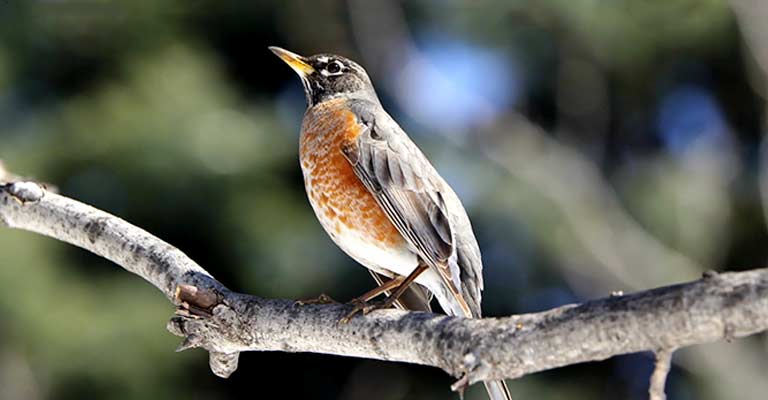
The male American robin exhibits a striking combination of colors. Its chest is adorned with rust-colored feathers, creating a distinct orange-red hue.
The rest of its body is characterized by gray-brown feathers, providing a subtle and earthy backdrop. The female, while sharing the same basic color palette, has paler head feathers that create a softer contrast with the gray back.
Head and Bill
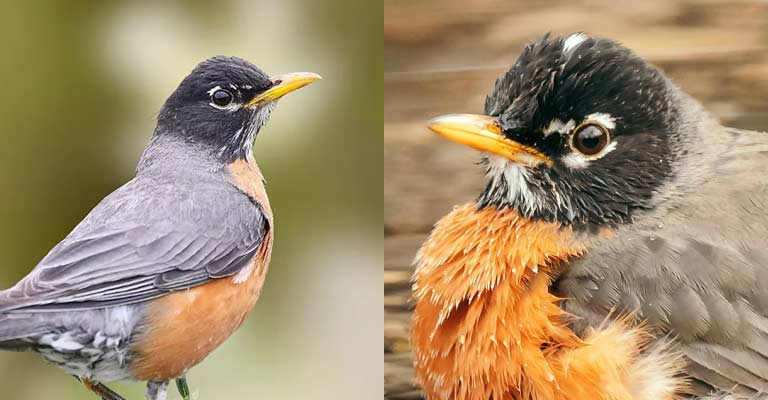
The male robin’s head is black, creating a stark contrast with its rust-colored chest. Additionally, it features white outlines around the eyes and on the throat, adding to its distinctive facial markings.
The bill is yellow, contributing to the bird’s overall vibrant appearance. The female’s head is less contrasting, with paler feathers that blend more subtly with the gray back.
Flight Characteristics
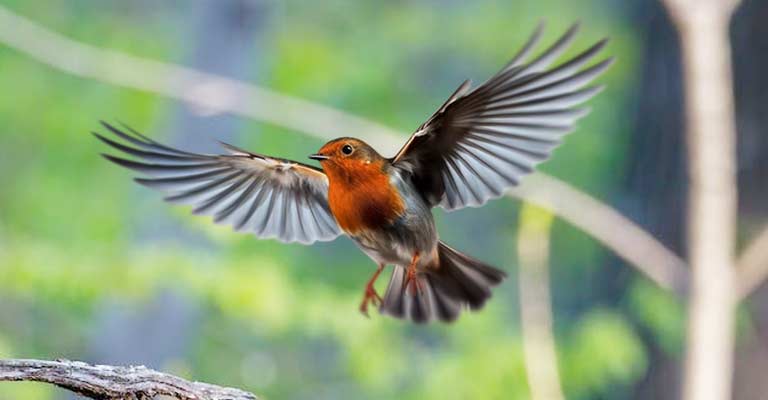
In flight, the American robin reveals a conspicuous white patch on the lower belly and under the tail.
This distinctive feature becomes noticeable and helps in identifying the bird even from a distance. The contrasting white adds an extra dimension to its appearance when in motion.
Foraging Behavior
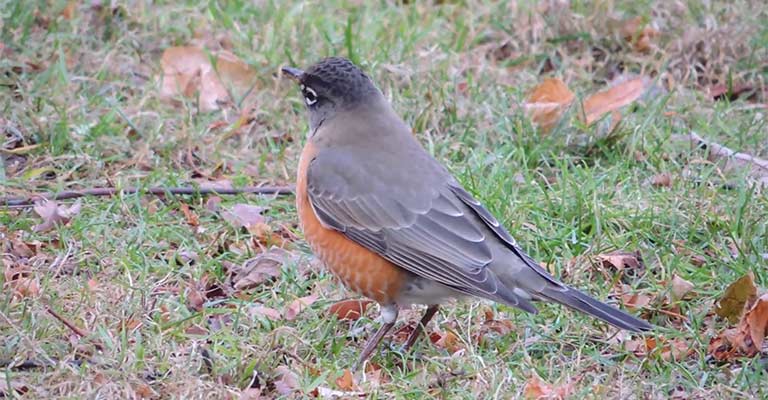
Robins are known for their foraging habits, often seen searching for food on lawns. They have a distinctive method of hunting, characterized by hopping on the ground and cocking their heads to detect movement in the soil.
This behavior is a common sight in yards across the continental United States, where robins are present year-round.
Song and Vocalizations
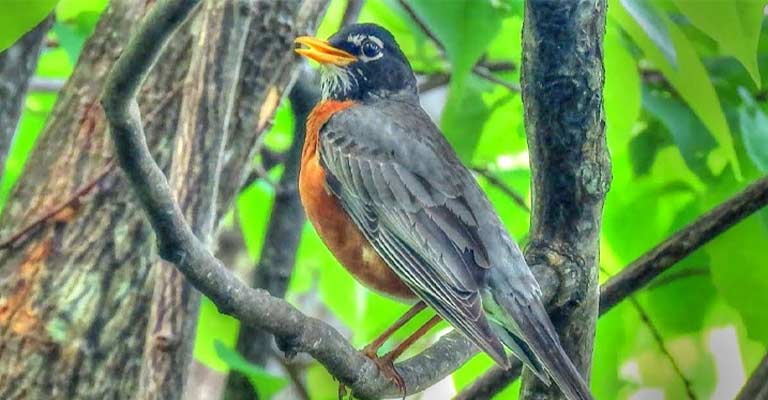
Apart from their visual characteristics, American robins are renowned for their cheery song.
Their melodious tunes are often associated with the arrival of spring, making them a symbol of the changing seasons. The male robin’s song is a series of rich, whistling phrases that contribute to the bird’s overall charm.
The American robin stands out with its large size, distinctive coloration, and engaging behaviors.
Whether seen foraging on a lawn, heard singing in the early spring, or observed in flight, its identifying characteristics make it a beloved and easily recognizable bird in North America.
Taxonomy
Here is a table summarizing the taxonomic information for the American Robin (Turdus migratorius):
| Taxonomic Level | Classification |
| Domain | Eukaryota |
| Kingdom | Animalia |
| Phylum | Chordata |
| Class | Aves |
| Order | Passeriformes |
| Family | Turdidae |
| Genus | Turdus |
| Species | T. migratorius |
The American Robin (Turdus migratorius) exhibits seven recognized subspecies, each displaying subtle variations in size, coloration, and distribution.
These subspecies, however, intergrade with one another, resulting in weakly defined distinctions.
- Eastern Robin (T. m. migratorius): Breeding in the U.S. and Canada, excluding the West Coast, this nominate subspecies ranges from Alaska and northern Canada to New England and south to Maryland.
- Newfoundland Robin (T. m. nigrideus): Breeding from coastal northern Quebec to Labrador and Newfoundland, this subspecies winters from southern Newfoundland south through most of the eastern U.S.
- Southern Robin (T. m. achrusterus): Breeding from southern Oklahoma east to Maryland and west to Virginia, it winters in the southern part of its breeding range.
- Northwestern Robin (T. m. caurinus): Breeding in southeastern Alaska through coastal British Columbia to Washington and northwestern Oregon, it winters from southwestern British Columbia to central and southern California.
- Western Robin (T. m. propinquus): Breeding from southeastern British Columbia to northern Baja California, it winters throughout much of its southern breeding range.
- San Lucas Robin (T. m. confinis): Breeding above 1,000 meters in the highlands of southern Baja California, it is distinct with pale gray-brown underparts.
- Mexican Robin (T. m. phillipsi): Resident in Mexico south to central Oaxaca, it is slightly smaller than the western subspecies but has a larger bill.
American Robin Life History
The American Robin (Turdus migratorius) is an iconic songbird that holds a prominent place in North American ecosystems.
Known for its distinctive appearance, melodious song, and adaptability, the life history of the American Robin encompasses various aspects from its feeding habits to breeding behaviors.
Food
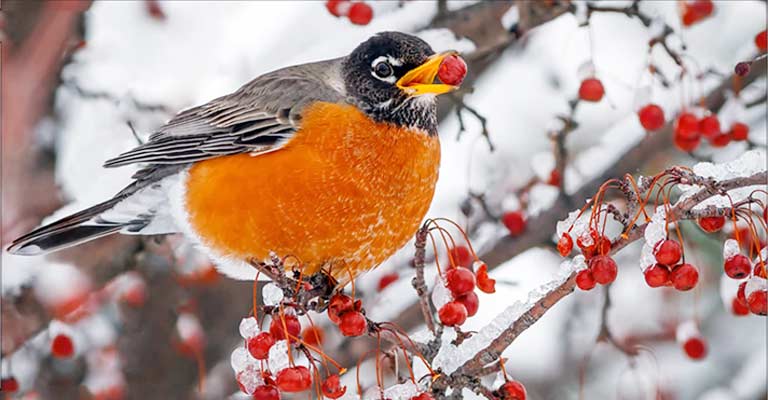
The American Robin (Turdus migratorius) is an omnivorous bird with a diverse diet. Its primary food sources include earthworms, insects, and other invertebrates, which it locates by sight and sound.
Robins are also known to consume fruits, berries, and, occasionally, small amphibians. Their foraging behavior often involves hopping on lawns, where they tilt their heads to listen for the movement of prey in the soil.
Habitat

American Robins are highly adaptable birds found in a variety of habitats, including woodlands, suburban areas, parks, and gardens.
They prefer open spaces with short grass where they can forage for insects. The availability of water sources is also essential for their survival.
Range Map
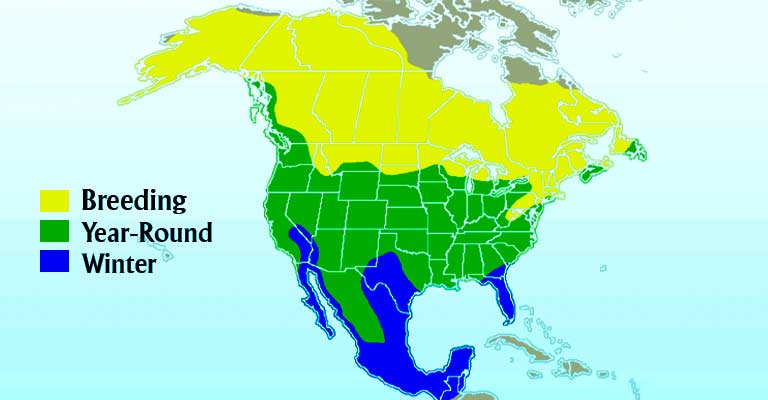
The range of the American Robin covers the entire continental United States, extending into southern Canada and parts of Mexico.
Their distribution can be influenced by seasonal migration, with some populations moving north to Alaska for the summer and returning to the southern parts of their range for the winter.
Nesting
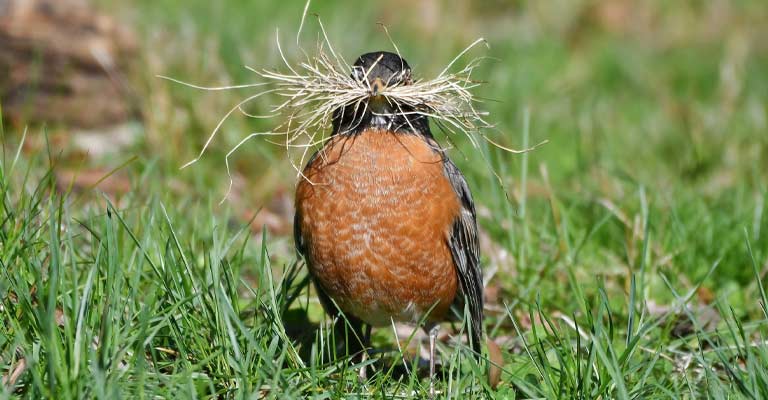
Robins are known for their cup-shaped nests, typically constructed with twigs, grass, and mud. The female is primarily responsible for building the nest, often situated in the crotch of a tree or on a building ledge.
They may also use artificial structures like eaves or hanging planters. The nest is lined with finer materials like grass and feathers.
| Nesting Facts of the American Robin | Details |
| Clutch Size | 3-5 eggs |
| Number of Broods | 1-3 broods |
| Egg Dimensions | Length: 1.1-1.2 in (2.8-3 cm) <br> Width: 0.8 in (2.1 cm) |
| Incubation Period | 12-14 days |
| Nestling Period | 13 days |
| Egg Description | Sky blue or blue-green and unmarked. |
Breeding
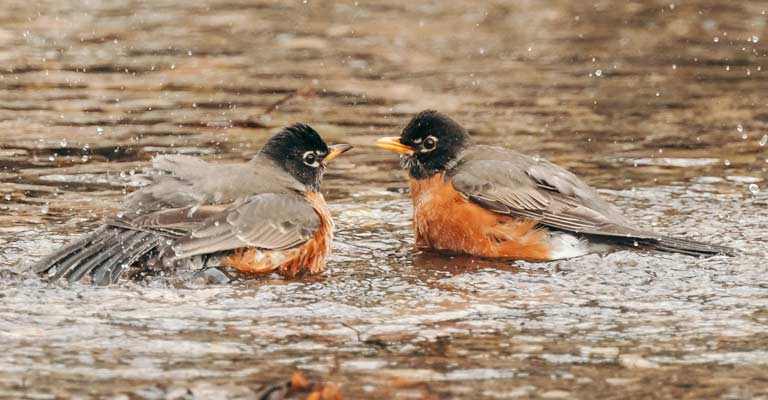
Breeding season for American Robins typically starts in early spring. Males establish territories and engage in courtship displays to attract females.
Once a pair forms, the female lays a clutch of 3-5 eggs, which she incubates for about two weeks. Both parents participate in feeding the nestlings, which fledge in about two weeks after hatching.
Diseases

American Robins can be susceptible to various diseases, including avian pox, avian influenza, and West Nile virus. Additionally, they may face threats from parasites like mites and lice.
Monitoring for signs of illness, such as lethargy or changes in plumage, is crucial for understanding and addressing potential health issues.
Treatment

If signs of disease or parasites are observed, it is important to contact wildlife rehabilitators or avian veterinarians for appropriate care.
Providing a clean and safe environment for birds in residential areas can help minimize the risk of disease transmission.
Conservation
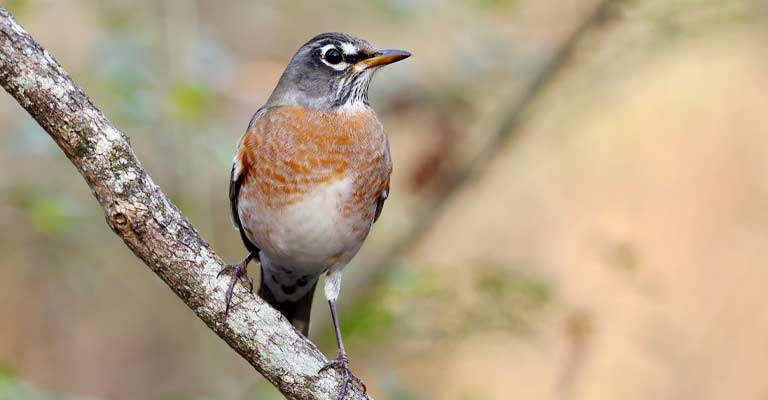
American Robins are widespread and generally abundant, but conservation efforts focus on maintaining their habitats, especially as urbanization continues.
Protecting open spaces, preserving native vegetation, and avoiding the use of pesticides in areas frequented by robins contribute to their conservation.
Citizen science projects, such as monitoring nest success and reporting sick birds, also play a role in understanding and conserving this iconic species.
Education and awareness campaigns can further promote coexistence between humans and these adaptable songbirds.
American Robin Fun Facts
Here are some amazing fun facts of the beautiful bird American Robin:
- Early Harbingers of Spring: American Robins are often considered a symbol of spring in North America. Their arrival is eagerly anticipated as a sign that winter is waning and warmer weather is on the way.
- Versatile Nesting Sites: While they traditionally build nests in trees or shrubs, American Robins have adapted to urban environments and may construct nests on buildings, window ledges, and even hanging planters.
- Distinctive Song: The American Robin’s song is a melodious series of clear whistles. Interestingly, each robin has its unique song, contributing to the overall rich avian symphony.
- Fruit-Eating Behavior: Unlike some songbirds, American Robins are known to eat a significant amount of fruit. During the winter months when insects are scarce, they rely on berries and fruit as a substantial part of their diet.
- Migratory Behavior: While some American Robins are year-round residents, others exhibit migratory behavior. Populations in the northern parts of their range migrate south for the winter, covering impressive distances.
- Foraging Techniques: When foraging for worms, American Robins are known to tilt their heads to the side to listen for the sounds of earthworms moving in the soil. This behavior, known as “head-cocking,” is a distinctive part of their hunting strategy.
- Multiple Broods: American Robins are capable of raising multiple broods in a single breeding season. Depending on factors like food availability and climate, they may produce one to three broods per year.
- Territorial Defenders: During the breeding season, male robins become territorial and may fiercely defend their nesting territory from intruders, including other robins.
- Distinct Subspecies: The American Robin has seven recognized subspecies, each with its own unique characteristics and distribution. These subspecies exhibit variations in size, coloration, and habitat preferences.
- Urban Adaptability: American Robins have adapted well to human-altered environments and are commonly seen foraging on lawns and in urban areas. This adaptability has contributed to their widespread presence across diverse landscapes.
Wrapping Up
The American Robin (Turdus migratorius) stands as an enduring symbol of North American landscapes, captivating observers with its vibrant plumage, melodious song, and adaptability.
From its distinctive orange-red breast to its versatile nesting habits, the robin plays a multifaceted role in ecosystems, contributing to the allure of changing seasons.
Known for its early arrival heralding spring, the robin’s migratory behavior, territorial defense, and urban adaptability showcase its resilience.
Beyond its aesthetic appeal, the American Robin plays a vital ecological role as a consumer of insects and distributor of seeds.
As a beloved and widespread species, this iconic songbird continues to inspire appreciation for the natural world.